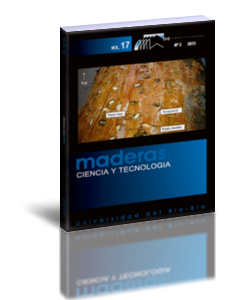Aplicación de celulosa nanofibrilada, en masa y superficie, a la pulpa mecánica de muela de piedra: Una sólida alternativa al tratamiento clásico de refinado
Keywords:
nanofibers, mechanical pulp, cellulosic fibers, beating, surface treatment, nanofibras, pulpa mecánica de muela de piedra, fibras celulósicas, refino, tratamiento superficialAbstract
Se ha estudiado el efecto de distintos dosajes en masa de nanofibras de celulosa (CNF ), comprendidas entre un 0 y un 6%, sobre las propiedades físico-mecánicas del papel obtenido a partir de las fibras de pasta mecánica de muela de piedra (SGW). Los resultados obtenidos se han comparado con el procedimiento convencional de refinado a distintos grados (de 0 a 2500 RPM). Posteriormente se ha estudiado la incidencia que tiene la aplicación superficial de las CNF en superficie, sobre el papel sin CNF en masa y con CNF en masa. Los resultados obtenidos mostraron que la rigidez del papel y su longitud de ruptura aumentaron con el grado de refino, sin embargo el grado Schopper – Riegler (ºSR) aumentó de forma importante dificultando el drenaje. La aportación de CNF en masa también aumentó el ºSR y la longitud de ruptura, de esta manera el ºSR de un refino a 1500 rev fue equivalente a un contenido en CNF de entre el 4,5 y 6%, pero su longitud de ruptura resultó ser sensiblemente superior. Puede concluirse que la aplicación de CNF en masa puede contemplarse como una alternativa al refino mecánico y que la aplicación superficial de CNF permite dotar al papel de mejores propiedades sin afectar a la capacidad de drenaje.
Abstract
The effect of different application amounts of nanofibrilated cellulose (CNF), from 0 to 6%, on the physico-mechanical properties of the paper obtained from stone ground wood pulp fiber has been studied. The results have been compared with the conventional beating process at different degrees (from 0 to 2500 rpm). Afterwards the effect of the application of CNF on the surface, in papers with and without CNF in bulk, has been studied. The results showed that the paper stiffness and breaking length increased with freeness; however the Schopper–Riegler grade (oSR) increased significantly hindering drainage. The contribution of CNF in bulk also increased °SR and breaking length, therefore the °SR beaten at 1500 rev was equivalent to a content of CNF between 4,5 and 6%, but its breaking length was found to be substantially greater. It can be concluded that the CNF in bulk can be viewed as an alternative to mechanical beating and that the application of CNF at the paper surface allows increasing strength properties without affecting the drainage capacity.

































